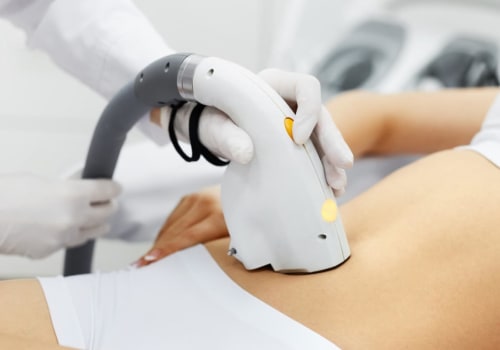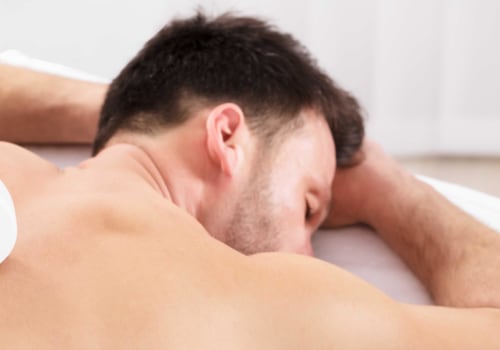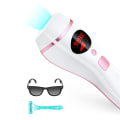Are you tired of dealing with razor burn and bumps? If so, you’re not alone. Razor burn and bumps can be painful and unsightly, making it difficult to feel confident in your skin. Fortunately, there is a solution: laser hair removal. By using laser hair removal technology, you can say goodbye to razor burn and bumps for good.
Laser hair removal is a safe and effective way to reduce or eliminate unwanted hair from the body. During the procedure, a handheld device emits a beam of light that passes through the skin and is absorbed by the melanin in the hair follicle. The laser energy heats up the hair follicles, destroying them and preventing them from producing new hairs. In addition to eliminating razor burn and bumps, laser hair removal can provide a number of medical benefits.
For example, it can help reduce ingrown hairs, decrease the risk of certain types of skin cancer, and improve the overall appearance of the skin.
Razor Burn
is a condition of the skin caused by shaving, waxing, or other forms of hair removal. It is characterized by redness, itching, and irritation. It can be caused by an incorrect shaving technique, using a dull razor blade, or shaving too closely to the skin. It is important to use proper techniques and products when shaving or waxing to prevent razor burn.Razor Bumps
are caused when the hair is cut too short and curls back into the skin after shaving or waxing.This can cause inflammation, redness, and bumps on the skin. These bumps may also be filled with pus and can be painful. Laser hair removal can be used to permanently reduce or eliminate razor bumps.
How Does Laser Hair Removal Help Eliminate Razor Burn and Bumps?
Laser hair removal is a medical procedure that uses concentrated light beams to target and destroy the hair follicles beneath the skin. The light beams cause the follicles to shrink and eventually stop producing hair.Because laser hair removal eliminates the root cause of razor burn and bumps—the hair follicle—it can provide long-term relief from these conditions.
The Medical Benefits of Laser Hair Removal
Laser hair removal can provide relief from razor burn and bumps, as well as other skin conditions such as ingrown hairs and dark spots. Additionally, laser hair removal can reduce or eliminate the need for frequent shaving and waxing. This can save time, money, and reduce the risk of skin irritation.How to Choose the Right Laser Hair Removal Clinic
When choosing a laser hair removal clinic, it is important to find one that is experienced and knowledgeable about laser treatments. Ask about the clinic's experience and research online reviews to ensure that the clinic you choose is reputable.Also, make sure to ask about any potential side effects or risks associated with laser hair removal.
Tips for Achieving Long-Term Smooth Skin
After laser hair removal treatments, it is important to take care of your skin. You should use gentle cleansers and moisturizers on your skin to keep it hydrated and avoid harsh products that can irritate your skin. Additionally, you should wear sunscreen when going outdoors and avoid tanning beds to prevent sun damage.FAQs About Laser Hair Removal and Razor Burn/Bumps
Q: How long do laser hair removal treatments last? A: Laser hair removal treatments typically last for several months before new hair begins to grow back. Q: Is laser hair removal safe? A: Yes, laser hair removal is a safe and effective treatment for reducing or eliminating unwanted body hair.Q: Is laser hair removal painful? A: Most people experience little to no discomfort during laser hair removal treatments.
Tips for Achieving Long-Term Smooth Skin
Razor burn and bumps can be a persistent issue, but there are ways to prevent them and achieve long-term smooth skin. Below are some tips for achieving long-term smooth skin with laser hair removal:Use SunscreenThe sun can be damaging to skin, so it's important to use sunscreen after laser hair removal treatments. Sunscreen will help protect your skin from the sun's harmful UV rays. Apply sunscreen daily and make sure to reapply every two hours if you're in the sun for an extended period of time.Avoid Waxing or Tweezing
It's important to avoid waxing or tweezing in between laser hair removal sessions.Waxing and tweezing can irritate the skin and cause razor burn and bumps. Laser hair removal is a more effective solution for achieving long-term smooth skin.
Stay Hydrated
Staying hydrated is key for maintaining healthy, smooth skin. Make sure to drink plenty of water throughout the day and avoid caffeinated beverages and alcohol, which can dehydrate the body.FAQs About Laser Hair Removal and Razor Burn/Bumps
How long do the results of laser hair removal last?The results of laser hair removal can be permanent. With a few treatments, the laser can target the hairs in the growth cycle, preventing them from growing back.However, some people may require touch-up treatments in the future.
How many treatments are needed for laser hair removal?
Depending on the area being treated and the individual's skin type, a series of 4-6 treatments may be required to achieve optimal results. Most people notice a reduction in hair growth after just a few treatments.Are there any side effects associated with laser hair removal?
The most common side effect associated with laser hair removal is temporary redness and swelling of the treated area. This usually subsides within a few hours. In rare cases, some people may experience blistering or discoloration of the skin, but these side effects are usually mild and temporary.What is Razor Burn and How Does it Occur?
Razor burn is a common skin irritation that can occur after shaving.It is characterized by redness, itching, and stinging on the skin. It usually occurs when the skin is dry, irritated, or sensitive. Razor burn can also lead to small bumps and ingrown hairs, which can be uncomfortable. Razor burn occurs when too much pressure is applied while shaving, causing the razor to pull at the skin. Other factors that can contribute to razor burn are using a dull razor blade, not shaving with enough lubrication, or shaving too close to the skin.
To avoid razor burn, you should use a sharp blade, shave with a moisturizing shaving cream or gel, and shave in the same direction as your hair growth. If you experience razor burn, you may notice redness and inflammation on the affected area. You may also feel an intense burning sensation or itching. If you have bumps due to razor burn, they will look like small red pimples that may be filled with pus. In order to treat razor burn, it is important to keep the affected area clean and moisturized. Applying a cold compress or hydrocortisone cream can help reduce swelling and discomfort.
Additionally, avoiding further shaving of the affected area until it heals can help prevent further irritation.
What Causes Razor Bumps?
Razor bumps, also known as pseudofolliculitis barbae, are a common skin condition caused by improper shaving techniques. When hair is shaved too close to the skin, it can curl back and grow into the follicle, creating an ingrown hair. Razor bumps are often caused by using a dull razor blade, shaving too closely to the skin, or having curly or coarse hair. This condition can be painful and cause redness, itching, and irritation. Ingrown hairs are the most common cause of razor bumps and can occur when the hair follicle gets blocked with dead skin cells or trapped by the surrounding skin tissue.Ingrown hairs can cause inflammation, itching, and redness. In severe cases, they can cause scarring. Recognizing the signs of razor bumps and ingrown hairs can help you determine the best course of treatment for your condition. Common signs of razor bumps and ingrown hairs include raised red bumps around the shaved area and itching or burning sensations. If you have razor bumps or ingrown hairs, you may also notice visible hair strands growing out from the center of the bump.
It’s important to avoid scratching or picking at the bumps as this can lead to infection and further irritation.
How Does Laser Hair Removal Help Eliminate Razor Burn and Bumps?
Razor burn and bumps can be an irritating problem for many people, but laser hair removal offers a permanent solution. Laser hair removal works by targeting the hair follicles with a concentrated beam of light. This light is absorbed by the melanin in the hair follicles, which leads to its destruction. The treatment will typically require multiple sessions over several weeks, depending on the size of the area being treated. The heat generated by laser hair removal also helps to reduce inflammation and irritation associated with razor burn and bumps.This reduces symptoms such as itching, redness, and swelling. The long-term effectiveness of laser hair removal means that once the area has been treated, there is no need for further treatments. Compared to other methods of hair removal such as shaving or waxing, laser hair removal is more effective and less painful. It also causes less skin irritation, making it an ideal solution for people who suffer from razor burn and bumps. The procedure also has a longer-lasting effect than other methods, meaning that you won't have to worry about razor burn or bumps reappearing after a few days. Overall, laser hair removal is an effective and safe way to get rid of razor burn and bumps for good.
It is a relatively pain-free procedure that can provide long-term results with minimal side effects. It is a great solution for those looking for an alternative to traditional methods of hair removal.
The Medical Benefits of Laser Hair Removal
For those looking to eliminate razor burn and bumps, laser hair removal can provide an effective solution. Unlike traditional shaving, laser hair removal can permanently reduce hair growth, leading to a smoother skin surface with fewer ingrown hairs, blemishes, and infections. One of the primary medical benefits of laser hair removal is the reduced risk of infection.Shaving with a razor can cause micro-tears in the skin, which can make it more susceptible to bacterial or fungal infections. Laser hair removal is a much gentler process that does not involve blades, reducing the risk of infection or inflammation. Laser hair removal also helps reduce the number of ingrown hairs that can occur after shaving. Ingrown hairs are caused when a strand of hair curls around and grows back into the skin. Laser hair removal helps prevent this by permanently reducing the amount of hair in the treatment area, leading to fewer ingrown hairs and less irritation. Finally, laser hair removal can help reduce blemishes.
Shaving often leads to razor burn and other skin irritations that can cause blemishes. Laser hair removal eliminates this problem by permanently removing unwanted hair and reducing skin irritation. In summary, laser hair removal provides numerous medical benefits for those looking to eliminate razor burn and bumps. By permanently reducing hair growth, laser hair removal can help reduce the risk of infection, ingrown hairs, and blemishes, leading to smoother skin and fewer skin irritations.
How to Choose the Right Laser Hair Removal Clinic
Razor burn and bumps can be an uncomfortable and embarrassing experience for many. Fortunately, laser hair removal offers a permanent solution for smooth skin with no more razor burn or bumps.When considering laser hair removal, it is important to choose a reputable clinic with experienced professionals. Here are some tips on how to choose the right laser hair removal clinic: 1.Research their credentials. Make sure the clinic is licensed, certified, and insured. It is also important to look into the qualifications of their staff, such as any certifications they may have.
2.Consult with a dermatologist. If you have any health concerns, it is best to consult with a dermatologist before getting laser hair removal. A dermatologist can assess your skin type and determine if laser hair removal is suitable for you. 3.Ask about the type of lasers used.
Different types of lasers are used for different skin types, so it is important to make sure the clinic uses the right type for your skin type. 4.Read reviews online. Reviews can give you an idea of the quality of service provided by a clinic and the results you can expect. By researching the credentials of the clinic and consulting with a dermatologist, you can ensure that you are choosing the right laser hair removal clinic for your needs.
Laser hair removal is a safe and effective way to get rid of razor burn and bumps, so make sure to choose a reputable clinic with experienced professionals to get the best results. In conclusion, laser hair removal offers an effective and permanent solution for eliminating razor burn and bumps. It not only reduces the risk of infection but also prevents ingrown hairs and blemishes. When selecting a laser hair removal clinic, it is important to research their credentials and consult with a dermatologist to ensure that you receive high-quality care. Following these tips can help achieve long-term smooth skin, allowing you to say goodbye to razor burn and bumps for good.







